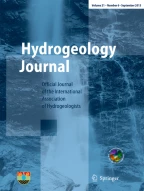236Accesses
Abstract
Within the realm of the Majapahit Empire, Indonesia (ca. 730 to 550 BCE), terracotta ring wells were used as latrines. Such use discontinued after the demise of the empire and no traces are found of them elsewhere in the Indonesian Archipelago. This mystery of their abandonment at Majapahit has never previously been explored but a viable solution is presented here based on historical precedents, hydrogeological reasoning and climate change.
Resume
Dans le royaume de l’Empire Majapahit, en Indonésie (environ 730 à 550 avant notre ère), des puits annulaires en terre cuite étaient utilisés comme latrines. Cette utilisation a cessé après la disparition de l’empire et aucune trace n’en a été trouvée ailleurs dans l’archipel indonésien. Ce mystère de leur abandon à Majapahit n'a jamais été exploré auparavant, mais une solution viable est présentée ici, basée sur des précédents historiques, un raisonnement hydrogéologique et le changement climatique.
Resumen
En el reino del Imperio Majapahit, Indonesia ( entre los años 730 y 550 a.C.), los pozos anulares de terracota se utilizaban como letrinas. Este uso se interrumpió tras la desaparición del imperio y no se encuentran vestigios de ellos en ningún otro lugar del archipiélago indonesio. El misterio de su abandono en Majapahit nunca se había explorado antes, pero en este artículo se presenta una solución viable basada en antecedentes históricos, razonamientos hidrogeológicos y el cambio climático.
摘要
在印度尼西亚Majapahit帝国(约公元前730至公元前550年)境内, 陶环井被用作厕所。在帝国灭亡后, 这种使用方式停止了, 并且在印度尼西亚群岛的其他地方也没有发现它们的痕迹。这个关于在Majapahit帝国遗弃陶环井的谜团之前从未被探索过, 但基于历史先例、水文地质推理和气候变化的考虑, 这里提出了一个可行的解决方案。
Resumo
Dentro do reino do Império Majapahit, na Indonésia (cerca de 730 a 550 aC), poços circulares de terracota eram usados como latrinas. Esse uso foi interrompido após o fim do império e não foram encontrados vestígios deles em outras partes do arquipélago indonésio. Este mistério do seu abandono em Majapahit nunca foi explorado anteriormente, mas uma solução viável é aqui apresentada com base em precedentes históricos, raciocínio hidrogeológico e alterações climáticas.
This is a preview of subscription content,log in via an institution to check access.
Access this article
Subscribe and save
- Get 10 units per month
- Download Article/Chapter or eBook
- 1 Unit = 1 Article or 1 Chapter
- Cancel anytime
Buy Now
Price includes VAT (Japan)
Instant access to the full article PDF.





Similar content being viewed by others
References
Abraham MG, Mathew AS, Thirumalini S, Baskar J (2021) Study and characterisation of ancient terracotta ring wells from Pattaraiperumbudur, Tamil Nadu, India. Materials Today: Proceedings 43, pp 1614–1621,https://www.elsevierco/locate/matpr. Accessed 21 Jan 2024
Chinnasamy P, Agoramoorthy G (2015) Groundwater Storage and Depletion Trends in Tamil Nadu State, India. Water Resour Manage 29:2139–2152.https://doi.org/10.1007/s11269-015-0932-z
Chusni A, Wayan IW, Nugroho IS (2023) Herry Y (2023) Geospatial analysis of the distribution of the Megalithic to colonial features of the Karangsambung-Karangbolong National Geopark, Kebunen, Indonesia and its surrounding area. Int J Geoheritage Parks 11(3):407–432.https://doi.org/10.1016/j.ijgeop.2023.06.002
George AR (2015) On Babylonian Lavatories and Sewers. IRAQ 77:75–106.https://doi.org/10.1017/irq.2015.9
Gomperts A, Haag A, Umbaran D, Subekti H (2018) New light on the archaeology of the Majapahit court capital. International Institute for Asian Studies. The Newsletter 79 Spring 2018
Hunter P, Carter RC, Macdonald AM (2010) Water Supply and Health. PLOS Med 7(11), https://www.ncbi.nlm.nih.gov/pmc/articles/PMC2976720/. Accessed 18 Feb 2024
Pande BM (1966) Ring wells in Ancient India. Bulletin of the Deccan College Post-Graduate and Research Institute Vol. 25, Silver Jubilee Volume (1966), p207–219 Published By: Vice Chancellor, Deccan College Post-Graduate and Research Institute (Deemed University)
Planetforlife Home Page, Global Warming (n.d.) The Earth's climate during the past 1000 years or Global warming and cooling during the past 1000 yearshttps://planetforlife.com/gwarm/glob1000.html accessed 28 February 2024
Sabbar AS, Nadhir Al-A TA (2020) Groundwater in Iraq. J Earth Sci Geotech Eng 10(1):155–197 ISSN: 1792–9660 (online) Scientific Press International Limited
Snow J (1855) On the mode of communication of cholera. London, John Churchill Tussniari PES, Adnyana IGAP
The Hans India (2021) Ancient ring well found at paddy field near Keeladi excavation site. Accessed 17 February 2024
Woolley CL, Mallowan MEL (1976). Ur Excavations 7. The Old Babylonian Period. Ed. T.C. Mitchell. London p22–23
Author information
Authors and Affiliations
Jakarta, Indonesia
Paul Whincup
Envirosolutions and Consulting, Jakarta, Indonesia
Riza Oktavianus & Chandra Egy
- Paul Whincup
You can also search for this author inPubMed Google Scholar
- Riza Oktavianus
You can also search for this author inPubMed Google Scholar
- Chandra Egy
You can also search for this author inPubMed Google Scholar
Corresponding author
Correspondence toPaul Whincup.
Ethics declarations
Conflicts of interest
The corresponding authors confirm that there are no conflicts of interest.
Additional information
Publisher's Note
Springer Nature remains neutral with regard to jurisdictional claims in published maps and institutional affiliations.
Rights and permissions
Springer Nature or its licensor (e.g. a society or other partner) holds exclusive rights to this article under a publishing agreement with the author(s) or other rightsholder(s); author self-archiving of the accepted manuscript version of this article is solely governed by the terms of such publishing agreement and applicable law.
About this article
Cite this article
Whincup, P., Oktavianus, R. & Egy, C. Hydrogeological solution to the 600-year-old mystery of the terracotta ring wells in Majapahit, Indonesia.Hydrogeol J32, 1781–1786 (2024). https://doi.org/10.1007/s10040-024-02832-9
Received:
Accepted:
Published:
Issue Date:


